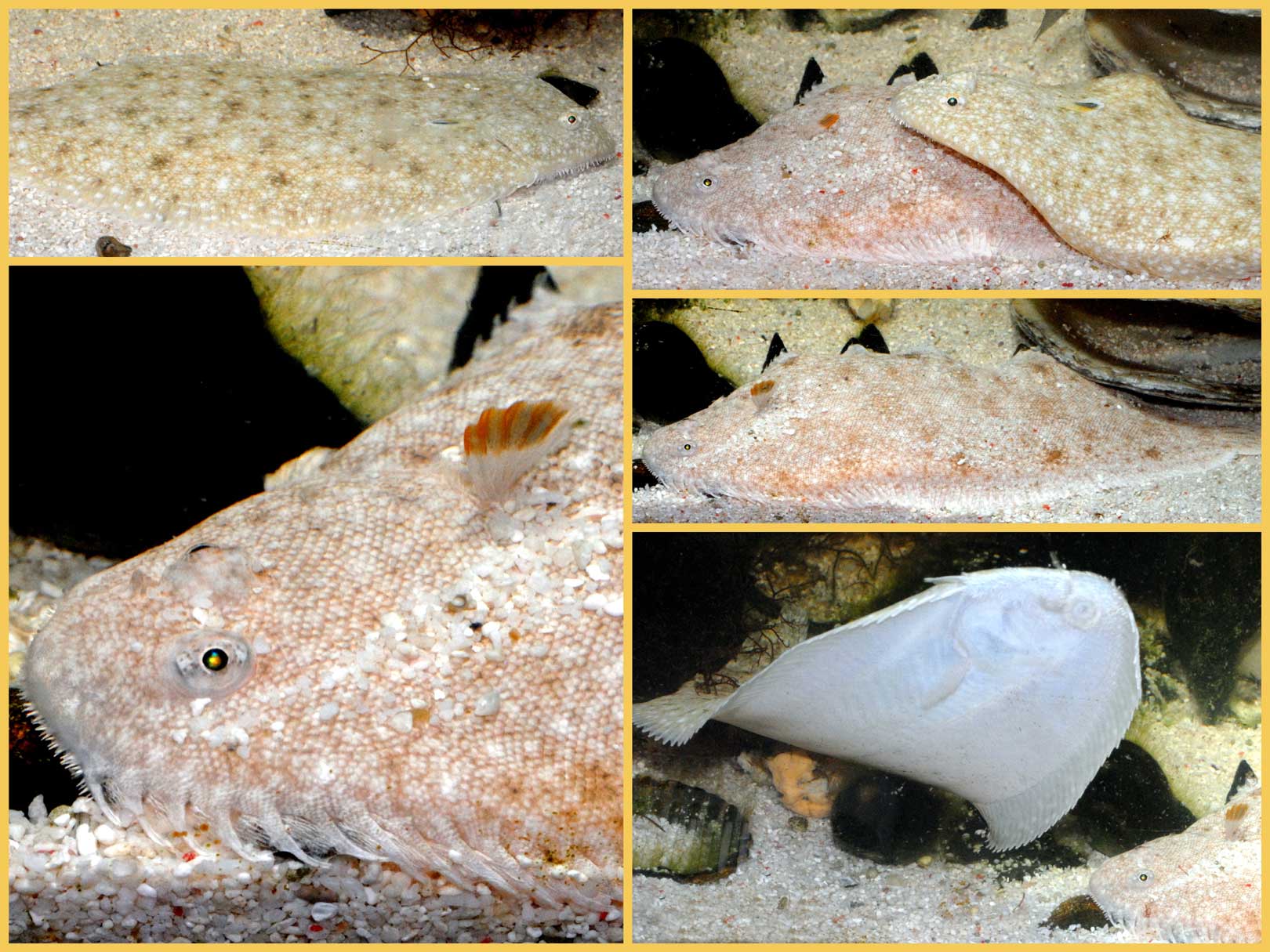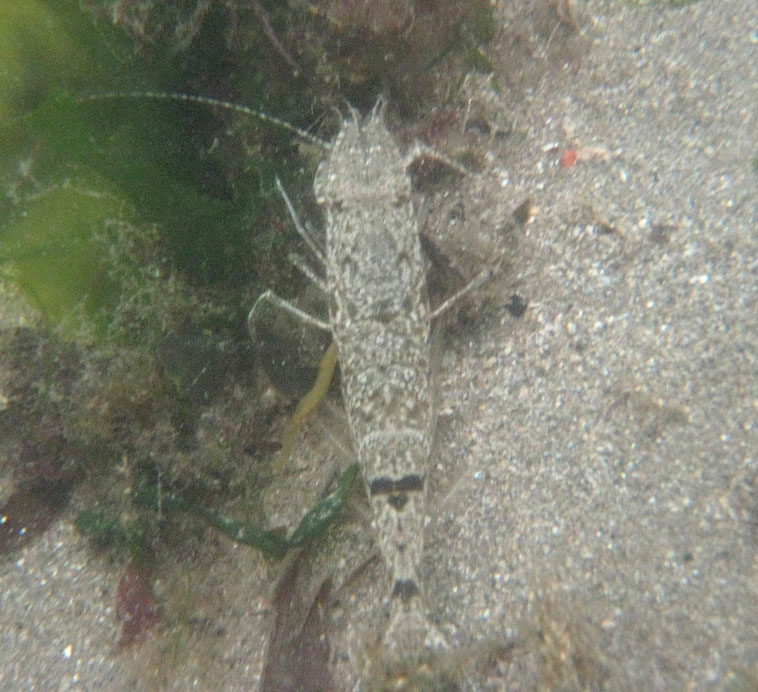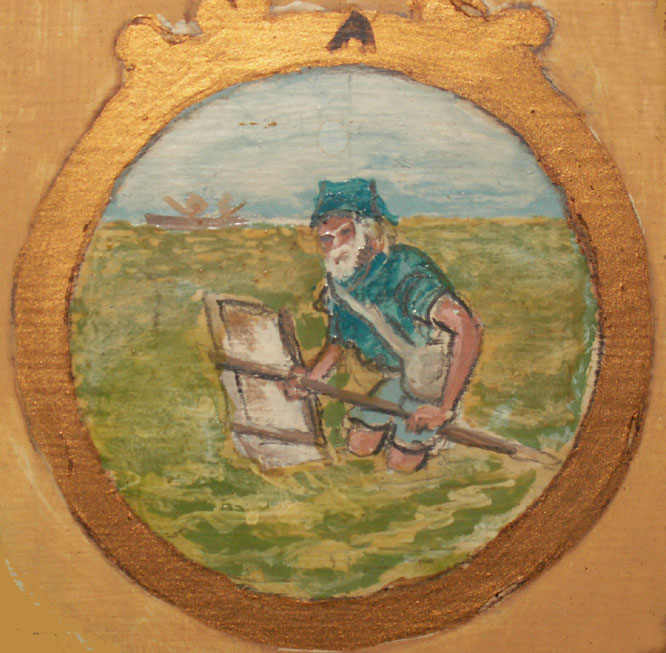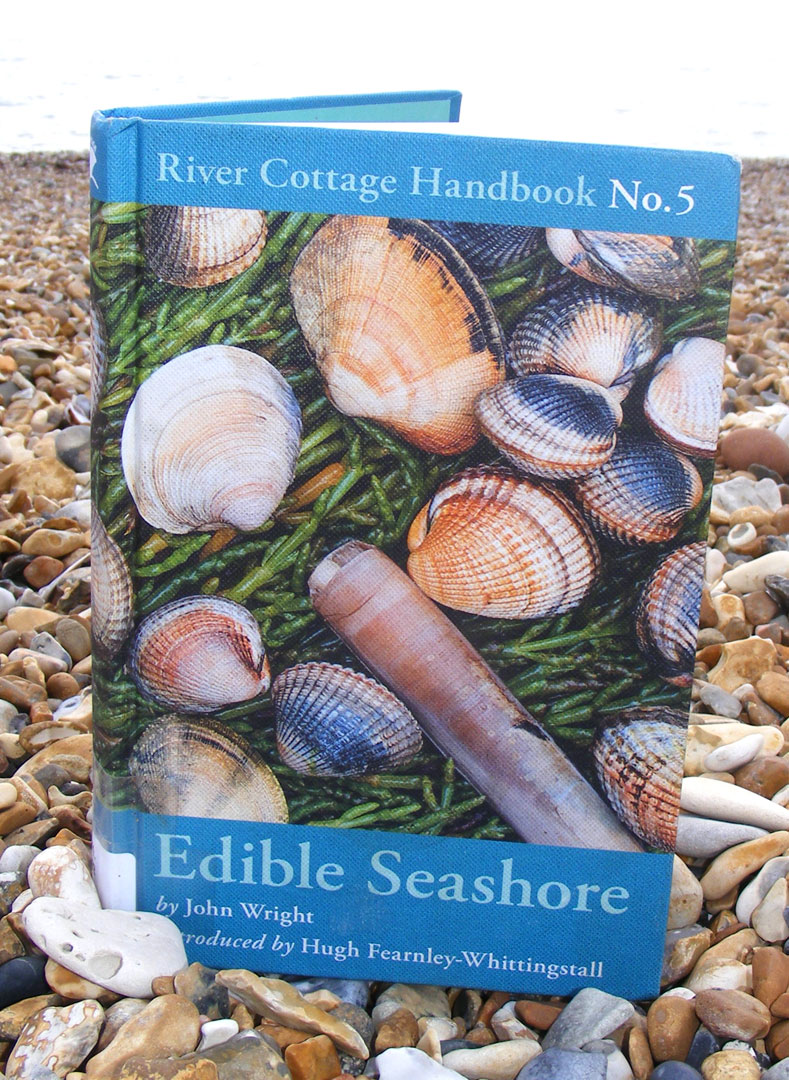Is it a Prawn
or a Shrimp?
Alas, there is no absolutely
correct answer. In common usage the names are interchangeable, and there
are lots of prawn-like or shrimp-like animals to confuse the novice rockpooler.
Marine biologists will use the scientific names.
However, the casual rockpooler
wanting to put a name to what he finds can follow the terms used for British
species only:

The Prawn
is transparent with long legs and is found amongst the weed in rock pools
on the shore. There are several different species. In the south and west
the species in the pools are called by the scientific name of Palaemon.

The Shrimp
is the sandy coloured crustacean that lives in the sandy shallows. It has
short legs and buries itself in the sand. It is called by the scientific
name of Crangon and is found all
around the British coast.

Brown Shrimp,
with discarded exoskeleton

Sand
Soles from Shoreham
I think
the species identified as Solenette (Slipper Sole),
Buglossidium
luteum, on these web page are really Sand
Sole, Pegusa lascaris

|
|
1)
Shoreham
2)
Westward Ho! |

|
|
1)
Shoreham
2)
Westward Ho! |
Sole
Comparisons
7 June
2016
As
bad shrimping
as I had ever known of Widewater (east) with just two Brown
Shrimps,
Crangon crangon,
and a one Vernal Crab, Liocarcinus
vernalis, but what made it worst was
the leaky waders (old waders by mistake) in the right boot side. Waders
came off easily though (that's because they were the old leaky ones!).
Arthritis impeded cycling on the Pashley more than pushing the larger shrimp
net. I arrived an hour before low tide (0.5 metres) and it might have been
better if I had left it later. (Shrimp net does not fit on the newer delivery
bicycle very well with the green plastic basket: it needs reorganising).
(New smaller shrimp net is in need of an awkward repair.)
9 June
2015
On
a low spring tide of 1.1
metres in the late afternoon in clear water
and there was ony one juvenile Brown Shrimp
and
nothing of interest a except five tiny Plaice
fry. Extraordinarily the Brown Shrimp
was short and squat, broader than its usual length*, although a small one.
(I used the new small shrimp net fro Lagoon Bait & Tackle, but it needed
repairs after the first trip out. It is easier to fold and unfold than
my remaining large net, which also needs alterations after its breakage
last year.) (*This could be have been
Philocheras,
a different species.)
22
September 2014
With
my larger mahogany shrimp net now repaired, this was its first outing on
what would not normally not be a favourable time for shrimping. I chose
Shoreham
Beach (opposite Shoreham Beach Green)
on a low spring tide of 1.1
metres in the late afternoon (5.00
pm) without too much optimism or enthusiasm
as the sky became cloudy.
I caught
about twenty Brown Shrimps,
Crangon
crangon, large enough not to fall
through the net in half an hour, plus six small to large Sand
Sole, Pegusa lascaris,
one Lesser Weever,
Echiichthys
vipera, three small South-clawed
Hermit Crabs,
Diogenes
pugilator, one Pennant's
Swimming Crab, Portumnus
latipes, and no other fish fry. One
of the Sand Soles was
estimated at 11 cm long and got itself caught twice after I returned the
fish the first time. This was so large I thought it could be a Dover
Sole, Solea solea, and this is
near its maximum size.
4 June
2014
A
single Peregrine Falcon
perched on a ledge on the Shoreham Harbour Power Station chimney on a ledge
where the nest box used to be.
It
was a low neap tide and just about suitable for
a brief morning spell of shrimping
(using Peter Talbot-Elsden's second smaller shrimp net) in the light rain
at Southwick Beach. There were hundreds of
Brown
Shrimps,
Crangon crangon,
including at least half of very small ones that were probably hatched this
year, about a dozen Pennant's Swimming
Crabs (the little speckled ones)
Portumnus
latipes, two South-clawed
Hermit Crabs,
Diogenes
pugilator, two very small Lesser
Weevers,
Echiichthys
vipera, an almost white Shore
Crab Carcinus
meanas, and a small Sand
Sole, Pegusa lascaris,
and
dozen small flatfish fry.
22
May 2014
Another
shrimping
expedition went completely wrong: my larger
mahogany shrimp net broke almost immediately. It was a major break and
will not be fixed without some craft woodwork.
21
May 2014
A
shrimping
expedition went completely wrong: my ancient
net broke almost immediately. "The shrimp
net was ancient, used to belong to Charlie
Woolgar, mussel, sandhopper and shrimp collector
for Regents
Park London Zoo Aquarium. When Chas retired the late John
Barker took over the role and most of his
kit. Charlie Woolgar
used to live in West Street, Shoreham. I remember
had a brass lobster
for a door knocker. He has been dead for decades." (Steve
Barker). It was a major break and will
not be fixed without some craft woodwork.
16
May 2014
A great
day with friends from Coastwise
North Devon at Westward
Ho!
Here are my finds from using a push net
at the edge of the sea: Brown Shrimp,
Crangon
crangon, the most obvious, five Pennant's
Swimming Crabs (the little speckled ones)
Portumnus
latipes, two South-clawed
Hermit Crabs,
Diogenes
pugilator, a small Lesser
Weever,
Echiichthys
vipera, (the black colour on the venomous
spines was clear), and a little Sand Sole,
Pegusa
lascaris.
The
Sand
Sole,
Pegusa lascaris, was a particularly
interesting discovery as this is a southern species and it is not often
recorded in British seas. I do not know if this a rare
fish
in British seas or just rarely recorded?
29
May 2013
An
overcast morning was a least dry and with little or no wind, it was the
first opportunity of a shrimping
expedition with the small one metre wide net to Lancing Beach by
Widewater on the low (0.2 metres) incoming tide
from 9:11 am.
There was disappointingly little caught apart from a pint of Brown
Shrimps, Crangon crangon,
one
small Common Hermit Crab,
Pagurus
bernhardus, and one South-clawed
Hermit Crab,
Diogenes
pugilator, a few tiny flatfish,
but no larger flatfish
or sand crabs
for Adur World Oceans
Day 2013. A small Shore
Crab Carcinus
meanas and one prawn
Palaemon
serratus, were incidentals together
with a dozen Slipper Limpet,
Crepidula
fornicata, clusters and a clump of
Squid
eggs.
2 May
2013
A
push-net shrimping expedition off Southwick
Beach, caught a meal of Brown Shrimp,
Crangon
crangon, plus some large venomous
Lesser
Weevers,
Echiichthys
vipera, as well as a few Sand
Sole, Pegusa lascaris
and 5-Bearded Rocklings,
Ciliata
mustela.
28
May 2012
A
special shrimping
trip to Lancing Beach (by Widewater)
(with Selena Barr and Philippa Lane from Field
magazine, and Peter Talbot-Elsden)
in ideal weather conditions (1.5 metre
neap low tide) caught three pints of Brown
Shrimps, Crangon crangon,
between
us. There was not much else in the nets: frequent flatfish
fry, two small Lesser
Weever,
Echiichthys
vipera, one swimming
crab Portumnus latipes with
"fleur-de lis"
markings, one Vernal Crab, Liocarcinus
vernalis, one badly damaged (but still
alive, it nipped me) Masked Crab, Corystes
cassivelaunus, a few large green Shore
Crabs,
Carcinus maenas,
and
a small Plaice,
Pleuronectes
platessa, (or possibly a Flounder?).

2
June 2011
After
the amount of weed
washed up on the shore after the sustained period of over a week of Force
5 Breezes, it was not promising for shrimping
off Lancing Beach by Widewater with
the sand just showing on 1.5 metres low tide in
the early evening. My fears were well founded, there was too much
weed
to make shrimping practical, with under ten Brown
Shrimps, Crangon crangon,
in just over half an hour push-netting. One very young Greater
Pipefish Syngnathus acus,
fry that came with the weed and quickly wriggled to escape through the
mesh of my smaller metre-wide shrimp net. It was the first capture, followed
by two
South-clawed Hermit Crabs,
Diogenes
pugilator, in Netted
Dogwhelk shells, one small Vernal
Crab, Liocarcinus
vernalis, just one small Sand
Sole, Pegusa lascaris,
and
two small flatfish fry.
Most of the Brown
Shrimps were
at the end of their life span and a few died in the bucket.
To compound the poor day, I cycled to the beach on the loaded Trade's Bike
against a south-westerly Force 3,
and whilst I was shrimping
the wind turned to the north-east and rose
to Force 4 and I could see this on the sea
as the white crests on the braking waves increased in frequency. I had
to cycle back against the wind as well.
23
April 2011
There
were almost ideal condition for shrimpingof
Lancing
Beach (east Widewater) with a gentle almost imperceptible swell, almost
negligible Light Breeze Force
2, (5 mph,
NNE), pleasant weather
with an air temperature of 18.9 °C
on the 9.50 am
low tide of 1.1 metres. Brown
Shrimps, Crangon crangon,
were
common (200+ caught in 40 minutes), although some were too small for the
pot. The water was clear and free of weed, but there was very little else
around. I caught two young Plaice,
Pleuronectes
platessa, one of which escaped and
a handful shot off at the approach of the smaller (one metre) semi-circular
shrimp net, and the only other incidentals were three very small Common
Hermit Crabs,
Pagurus bernhardus,
(i.e. not Diogenes)
in
Grey Topshells and Netted
Dogwhelk shells. Advection
fog set in over the sea as the tide
turned and the visibility was diminished to under 50 metres.
Met
Office: Shoreham
27
May 2010
Ever
such a lot, at least two pints of Brown
Shrimps,
Crangon crangon,
in the shrimp-net off Widewater, but there was nothing else of interest
in the net except for frequent flatfish
fry and a handful of small Sand
Sole, Pegusa lascaris.
21
May 2010
My
first shrimping outing of the year using my smaller three foot wide shrimp
net on the medium tide on Lancing Beach (Widewater
West) yielded a rather poor 30 or so Brown
Shrimps,
Crangon crangon,
but not enough exhibits for Adur World Oceans Day
2010: a left-eyed flatfish*
that was too large for the aquarium, only a very small Sand
Sole, Pegusa lascaris,
two
South-clawed Hermit Crabs,
Diogenes
pugilator, one very small Vernal
Crab, Liocarcinus
vernalis, and an even smaller tiny
swimming
crab Portumnus latipes was the
total catch in an hour on a tide that had not receded enough.
| *The
flatfish was identified as a Turbot,
Psetta
maxima, measuring 180 mm (excluding
the caudal fin) long and 80 mm wide (excluding fins) and weighing about
125 grams. |
 |
June
2009
The
Edible
Seashore (River Cottage Handbook No. 5)
by
John
Wright
is
published
Book
Review
3 June
2009
A
Force
4 easterly Breeze prevented any serious
shrimping on Southwick Beach as the waves
rolled in. A quick ten minute push on the outgoing
tide
produced a medium-sized Lesser Weever,
Echiichthys
vipera, one swimming
crab Portumnus latipes with
"fleur-de lis"
markings, five Brown Shrimps,
Crangon
crangon, and two flatfish
(probably
Plaice) fry.
British
Intertidal Crabs
 29
May 2009 29
May 2009
Shrimping
was possible after some poor weather. And the conditions were ideal off
Lancing
Beach (near the Church of the Good Shepherd) but the haul of Brown
Shrimps,
Crangon crangon,
amount to about thirty all after the tide turned
and with the incoming tide. Luckily (because the expedition was to get
exhibits for Adur World Oceans Day 2009) the
haul with my smaller U-shaped net including two medium-sized Lesser
Weevers,
Echiichthys
vipera, amongst the weed so I had
to be careful of the venomous fins,
two adult Sand Sole, Pegusa
lascaris,
one intact Vernal Crab Liocarcinus
vernalis, half a dozen flatfish
(probably
Plaice) fry, one small Plaice,
two
South-clawed
Hermit Crabs,
Diogenes pugilator,
one swimming crab Portumnus latipes,
and a very young Greater Pipefish Syngnathus
acus. A Painted
Lady Butterfly fluttered around my head.
23
May 2009
The
early evening shrimping expedition at Lancing (by Widewater) was exceptionally
poor registering just half a dozen Brown
Shrimps, Crangon crangon,
with most of them too small and one large one escaped through the net meshing.
Incidental captures were exiguous: three very young Greater
Pipefish Syngnathus acus,
three Sand Sole, Pegusa
lascaris,
two one-clawed Vernal Crabs Liocarcinus
vernalis, half a dozen flatfish
(probably
Plaice) fry, one South-clawed
Hermit Crab,
Diogenes pugilator,
and a Lesser Spotted Dogfish Scyliorhinus
canicula pursewith
an embryo.
There was a much darker brown different pipefish that escaped the net.
This could have been either a juvenile Worm Pipefish Nerophis
lumbriciformis, or even a juvenile
Snake
Pipefish Entelurus aequoreus. A
clump of the black grape-like Cuttlefish
eggs were discovered washed up on
the strandline.
Tide
height: 0.84 metres
Brown
Shrimp, Crangon crangon,
photographed
whilst snorkelling off Stonycove - a tiny little village near
Kinsale,
County Cork.
|
 |
12
May 2008
Even
more perfect conditions, a bit cooler and no breeze and only the occasional
rogue swell from a passing ship, my Brown
Shrimp, Crangon crangon,
haul at Southwick Beach was about two pints.Other
captures in the shrimp nets were a few shrimp length Lesser
Weever,
Echiichthys
vipera, a few small to full sized
Sand
Sole, Pegusa lascaris,
one large fully grown 5-Bearded Rockling,
Ciliata
mustela, (which looked very much like a 3-Bearded
Rockling,
Gaidropsarus
vulgaris, until the beards were counted),
one juvenile Dragonet,
Callionymus
lyra,
a few Vernal
Crabs,
Liocarcinus
vernalis, one damaged (missing a claw)
Masked
Crab, Corystes cassivelaunus,
about a dozen Shore Crabs, Carcinus
maenas, with a few netted eating shrimps,
a few very small swimming crabs Portumnus
latipes, one South-clawed
Hermit Crab,
Diogenes pugilator,
in a Sting Winkle
shell, and a colourful Little Cuttle Sepiola.
BMLSS
Crabs of the Seashore
11
May 2008
Perfect
shrimping conditions were encountered on the morning low tide at Southwick
Beach (1.2 metres
at 10:40 am)
on a sunny hazy day with an air temperature of 22.1
°C and a gentle swell. The haul included
plentiful Brown Shrimps, Crangon
crangon, with all three shrimpers
getting more than enough for a meal each in under an hour, one fully grown
Lesser
Weever,
Echiichthys
vipera, and a few small ones, a few
small Sand Sole, Pegusa
lascaris, a
few Vernal Crabs, Liocarcinus
vernalis, one damaged (missing a claw)
Masked
Crab, Corystes cassivelaunus,and
two
green Shore Crabs, Carcinus
maenas.

Three
Photographs by John
Wright
Edible
Seashore (River Cottage Handbook No. 5)
5 May
2008
On
Bank
Holiday Monday, it felt warm for the first
time this year as the temperature reached 20.0
°C at midday.
The wind was from the south-east at 13 mph (Force
2) on the low tide
in the late afternoon.
Shoreham
Weather
My
first shrimping expedition
of the year at Lancing produced a moderate
amount of Brown Shrimps, Crangon
crangon, plus one Lesser
Weever,
Echiichthys
vipera, one small Sand
Sole, Pegusa lascaris,two
Vernal
Crabs, Liocarcinus
vernalis, and South-clawed
Hermit Crabs,
Diogenes pugilator,
amongst more weed than is usual at the beginning of May.
The Force 2 produced an occasional wave with a breaking whitecap.
The main problem (east of Lancing Sailing Club) was a patch of soft sand
(almost certainly caused by bait digging).
Sussex
Marine Life
27
April 2008
Early
morning shrimping was poor with just 20 Brown
Shrimps, Crangon crangon.
Report
by Peter Talbot-Elsden
8
June 2007
Whilst
shrimping off Southwick, I caught two Thornback
Rays, Raja clavata, in the large
push-net. The largest of the rays was estimated at over 20 cm across the
wings.
Report
by Peter Talbot-Elsden
4
June 2007
Shrimping
at Southwick produced one Sole.
Solea
solea, six small Sand
Sole, Pegusa lascaris,
two types of Hermit Crabs,
and sandy coloured crabs
as well.
Report
by Peter Talbot-Elsden
BMLSS
Hermit Crabs
24
May 2007
A
shrimping expedition to Lancing Beach
(just to the west of Lancing Sailing Club) on a low neap 1.9 metre tide
revealed the sandy shallows and a clear sea on a calm day and the haul
in 40 minutes or so using my small 60 cm push-net was about 100
Brown
Shrimps Crangon crangon,
small flatfish fry,
one small Plaice,
occasional small Sand Sole, Pegusa
lascarisand one second year
Sole.
Solea
solea, a handful of South-clawed
Hermit Crabs,
Diogenes pugilator,
a
few very small
Common Hermit Crabs,
Pagurus
bernhardus in Grey
Topshells, one Vernal
Crab, Liocarcinus
vernalis, and a few of the swimming
crabs Portumnus latipes.
BMLSS
Crabs
16
March 2007
My
first shrimping (using my 2 foot wide folding net) expedition of 2007
took me to a breezy (Force
4) Shoreham Beach (just west of Weald
Dyke) and half an hour push-netting brought me about twenty Brown
Shrimps, one Shore
Prawn, a small Plaice
and
three Vernal Crabs, Liocarcinus
vernalis.
BMLSS
Crabs of the Seashore
16
June 2006
The
shrimp
haul at
Southwick
included a Little Cuttle and
a 5-Bearded Rockling,
Ciliata
mustela.
Report
by Peter Talbot-Elsden
31
May 2006
One
day later, the junior shrimp net
was repaired with a bolt and wing-nut and there were over a hundred Brown
Shrimps off Lancing
beach (east Widewater), a handful of South-clawed
Hermit Crabs,
Diogenes pugilator and
a colourful Little Cuttle Sepiola,
a small Sand Sole, Pegusa
lascaris and flatfish
fry.
Intertidal
2006
BMLSS
Prawns & Shrimps

30
May 2006
My
junior (metre wide) shrimp net
broke under the weight of loose mixed seaweed off Lancing beach (east Widewater)
and there were just two Brown Shrimps
and a South-clawed Hermit Crab,
Diogenes
pugilator,
in a Netted
Dogwhelk shell.
5 March
2006
A
shrimping expedition (push-net) to the sandy shallows of Southwick
beach produced four small Sand-eels,
Ammodytes tobianus, but these were so
small that most of these elongate fish would have escaped through the netting.
Small fish fry were caught in the net as well.
Report
by Peter Talbot-Elsden
Tim
Hoy with a home made shrimp-net in Ireland 2004
2
May 2005
A
Sand
Sole, Pegusa lascaris,
and
a Plaice
in the shrimp push-net off Southwick, but there were only ten Brown
Shrimps on the low neaps. This is a very
poor shrimping return for April or May. However,
these two fish have not been knowingly caught before whilst shrimping or
rockpooling,
so this was a successful outing.

Loaded Shrimping Bikes
at Southwick beach
Pashley-Hercules hybrid
and a Gundle
These
are only small lightweight push-nets that can be used as supplementary
nets whilst rockpooling and not strong or large
enough for practical shrimping.

Peeled
Shrimps

19
June 2003
SHRIMPING
FOR FOOD AND FUN
 Local
shrimper Peter Talbot-Elsden, from Southwick (Sussex),
has produced a small booklet called “Shrimping for Food and Fun”
about catching the brown shrimp around the coasts of Britain. The shrimps
are caught in nets and the book features the various methods, firstly the
push-netting seen over the sand in shallow water in spring off the Sussex
coast. The famous Morecambe Bay shrimps were originally captured by cart
shanker shrimping with a horse and cart in deeper water off the Lancashire
coast, later replaced by a tractor. At Formby, they experimented with amphibious
vehicles after World War II. Nowadays, most commercial shrimping on the
east coast around King’s Lynn trawls from small boats using a net off the
stern. Shrimps are often cooked on board. Local
shrimper Peter Talbot-Elsden, from Southwick (Sussex),
has produced a small booklet called “Shrimping for Food and Fun”
about catching the brown shrimp around the coasts of Britain. The shrimps
are caught in nets and the book features the various methods, firstly the
push-netting seen over the sand in shallow water in spring off the Sussex
coast. The famous Morecambe Bay shrimps were originally captured by cart
shanker shrimping with a horse and cart in deeper water off the Lancashire
coast, later replaced by a tractor. At Formby, they experimented with amphibious
vehicles after World War II. Nowadays, most commercial shrimping on the
east coast around King’s Lynn trawls from small boats using a net off the
stern. Shrimps are often cooked on board.
The
28 page book contains 40 photographs of shrimping through the ages. It
is available through Bookworms of Shoreham
and other booksellers and museums at £3.50. (It does NOT contain
details of how to make a shrimp net.)
The
booklet is still available through the British
Marine Life Study Society, but at £4 including postage and packing.
The cheque should be made payable to the BMLSS and sent to:
British
Marine Life Study Society
Shrimping
Booklet
Glaucus
House
14
Corbyn Crescent
Shoreham-by-Sea
West
Sussex
BN43
6PQ
The
booklet can now be ordered directly from by
Peter
Talbot-Elsden.
Peter
Talbot-Elsden manned the shrimp display
at Adur World Oceans Day.
To
obtain your Shrimping Book,
please telephone Peter Talbot-Elsden @ 01273
591846 or EMail: crangon11@gmail.com
Brown
Shrimp on Wikipedia
FAO
Brown Shrimp
Handling
and processing shrimp (Torry Research Station) FAO
Brown
Shrimp (MarLIN)
Shrimping
on the Thames (by Charles Dickens)
The
last horse fishermen of Belgium, Oostduinkerke on the West Flanders coast
is the only place in the world where you will still see the 500-year-old
tradition of fishermen trawling for shrimp on horseback.
Horseback
Shrimp Fishing, Oostduinkerke
Shrimping
by Boat (Commercial, Netherlands)
Shorewatch
Project EMail Glaucus@hotmail.com
All messages will receive
a reply.
|
































